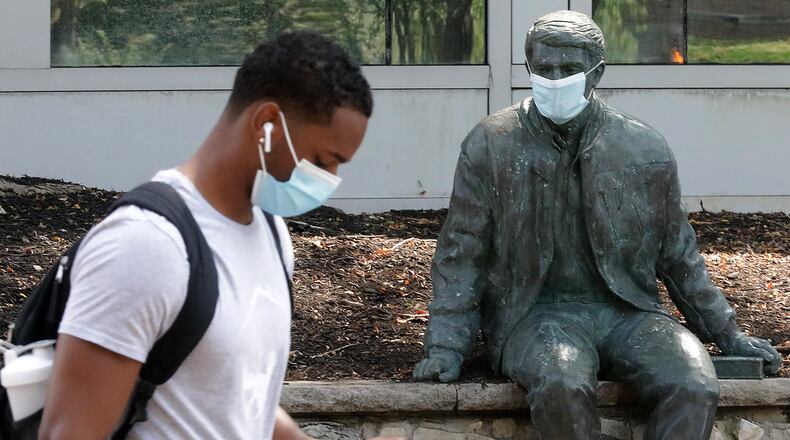Wittenberg, located in Springfield, recorded total 76 active cases on Thursday, according to their website, which is a significant increase from last week.
“We saw our case numbers increase from two, one of which was resolved, last Monday to 22 (this weekend),” said Wittenberg President Michael Frandsen who joined the governor via videoconference.
Frandsen told the governor the university made the decision to temporarily move to remote learning after seeing the rapid rise in cases. Students will use the distance learning model for at least the next two weeks.
Through contact tracing, Frandsen said the university has been able to determine that spread of the virus has been taking place “in residential areas and social gatherings, not in the classroom or dining halls."
“We have about 60 houses adjacent to campus that anywhere from three to five students live in, so we are fortunate in that we aren’t seeing spread in our dormitories. We are seeing the spread in those residential housing units, neighbors to neighbors, block to block, but not so much in our residence halls,” Frandsen said.
At a free mass-testing event on Wednesday hosted by the Ohio National Guard in partnership with the Clark County Combined Health District, 446 people were tested for the virus, Frandsen said.
Results from those tests are expected back “by the end of the week,” Frandsen said. He added that he hopes the results will help the university get “a better picture of where we are at.”
“If the tests show that we were missing a lot of what was going on campus, we are going to have to rethink just how long we pause in-person instruction,” Frandsen.
The county’s level 2 streak will likely come to an end next week after results from that testing event come in, Charles Patterson, Clark County Health Commissioner said.
That’s because the advisory system’s level ranking is based on data from the last two weeks, not including this week, Patterson said. For example, this week’s ranking was based on data from Aug. 27 until Sept. 3.
This means that Thursday’s ranking doesn’t take into account the recent spike of cases at Wittenberg University, Patteson said.
“We won’t be surprised if we go into the red next week because of the number of cases we have seen in the last week,” Patterson said.
Clark County has frequently bounced between level 2 and level 3 since Gov. Mike DeWine unveiled the advisory system on July 2. The first time the county hit level 3 was on July 23. The county then dropped back to level 2 for a couple of weeks before moving back to level 3 on Aug. 20.
Since then, the county has remained at level 2.
The advisory system ranges from level 1 or yellow as lowest to level 4 or purple as highest and most severe. No county has received a purple rating.
The seven indicators the Ohio Department of Health uses when judging what level to give a county are: new cases per capita, sustained increase in new cases, proportion of cases not in a congregate spread, sustained increase in emergency department visits for COVID-like illness, sustained increase in outpatient visits for COVID-like illness, sustained increase in new COVID hospital admissions and intensive care unit bed occupancy.
Last week, Clark County hit just two indictors: new cases per capita and proportion of cases not in a congregate spread.
This week the county hit two again, however, they were: new cases per capita and sustained increase in new cases.
Between Aug. 27 and Sept. 3, the county saw the average number of COVID-19 cases per day increase from 9.57 to 15.57, according to the Ohio Department of Health.
Clark County had 1,565 cases, 33 deaths and two probable deaths of the coronavirus as of Thursday afternoon, according to ODH.
Statewide, six counties were given a level 3 ranking this week. Over half the counties are in the Miami Valley and include Montgomery, Butler, Preble and Mercer County.
During his press conference, DeWine announced Dr. Joan Duwve will serve as the next Ohio Department of Health director, following Dr. Amy Action’s resignation earlier this year.
Duwve, a native Ohioan, worked as the director of public health at the South Carolina Department of Health and Environmental Control.
She previously worked with Indian Gov. Eric Holcomb and former Indiana governors Mitch Daniels, Mike Pence. She has served as the chief medical officer with the Indiana Department of Health and as the medical director of the department’s division of public health and preparedness.
Duwve is a graduate of the Ohio State University and North Olmsted High School near Cleveland.
She is expected to begin her role as head of ODH around Oct. 1.
Ohio reported 134,086 total cases and 4,354 deaths of the coronavirus on Thursday, according to ODH. Between Wednesday and Thursday, the state reported 1,121 new cases and 30 new deaths both of which are above the 21-day average of 1,052 and 20.
Facts & Figures:
2: Clark County’s new Ohio Public Health Advisory System level
1,565: Total cases of the coronavirus in Clark County
33: Confirmed coronavirus death in Clark County
Source: Ohio Department of Health
About the Author

